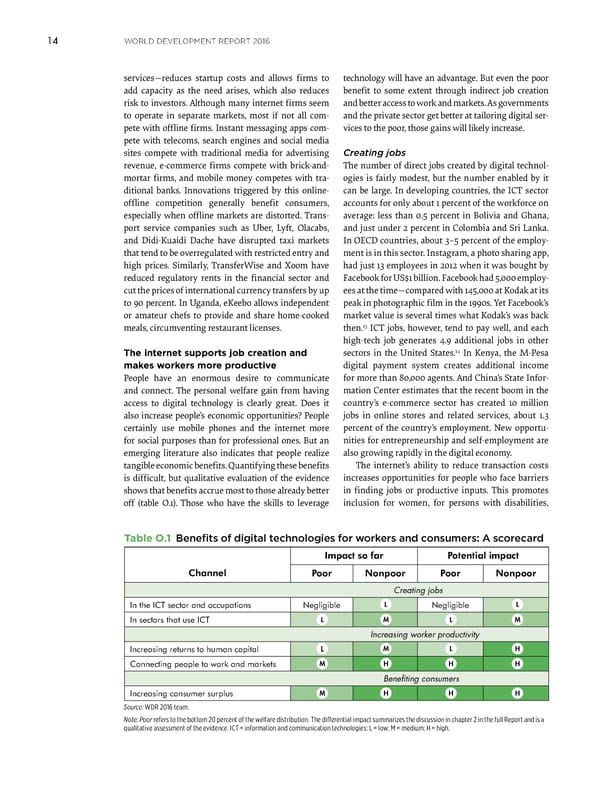WORLD DEVELOPMENT REPORT 2016 14 services—reduces startup costs and allows firms to technology will have an advantage. But even the poor add capacity as the need arises, which also reduces benefit to some extent through indirect job creation risk to investors. Although many internet firms seem and better access to work and markets. As governments to operate in separate markets, most if not all com- and the private sector get better at tailoring digital ser- pete with offline firms. Instant messaging apps com- vices to the poor, those gains will likely increase. pete with telecoms, search engines and social media sites compete with traditional media for advertising Creating jobs revenue, e-commerce firms compete with brick-and- The number of direct jobs created by digital technol- mortar firms, and mobile money competes with tra- ogies is fairly modest, but the number enabled by it ditional banks. Innovations triggered by this online- can be large. In developing countries, the ICT sector offline competition generally benefit consumers, accounts for only about 1 percent of the workforce on especially when offline markets are distorted. Trans- average: less than 0.5 percent in Bolivia and Ghana, port service companies such as Uber, Lyft, Olacabs, and just under 2 percent in Colombia and Sri Lanka. and Didi-Kuaidi Dache have disrupted taxi markets In OECD countries, about 3–5 percent of the employ- that tend to be overregulated with restricted entry and ment is in this sector. Instagram, a photo sharing app, high prices. Similarly, TransferWise and Xoom have had just 13 employees in 2012 when it was bought by reduced regulatory rents in the financial sector and Facebook for US$1 billion. Facebook had 5,000 employ- cut the prices of international currency transfers by up ees at the time—compared with 145,000 at Kodak at its to 90 percent. In Uganda, eKeebo allows independent peak in photographic film in the 1990s. Yet Facebook’s or amateur chefs to provide and share home-cooked market value is several times what Kodak’s was back meals, circumventing restaurant licenses. then.13 ICT jobs, however, tend to pay well, and each high-tech job generates 4.9 additional jobs in other The internet supports job creation and sectors in the United States.14 In Kenya, the M-Pesa makes workers more productive digital payment system creates additional income People have an enormous desire to communicate for more than 80,000 agents. And China’s State Infor- and connect. The personal welfare gain from having mation Center estimates that the recent boom in the access to digital technology is clearly great. Does it country’s e-commerce sector has created 10 million also increase people’s economic opportunities? People jobs in online stores and related services, about 1.3 certainly use mobile phones and the internet more percent of the country’s employment. New opportu- for social purposes than for professional ones. But an nities for entrepreneurship and self-employment are emerging literature also indicates that people realize also growing rapidly in the digital economy. tangible economic benefits. Quantifying these benefits The internet’s ability to reduce transaction costs is difficult, but qualitative evaluation of the evidence increases opportunities for people who face barriers shows that benefits accrue most to those already better in finding jobs or productive inputs. This promotes off (table O.1). Those who have the skills to leverage inclusion for women, for persons with disabilities, Table O.1 Benefits of digital technologies for workers and consumers: A scorecard Impact so far Potential impact Channel Poor Nonpoor Poor Nonpoor Creating jobs In the ICT sector and occupations Negligible L Negligible L In sectors that use ICT L M L M Increasing worker productivity Increasing returns to human capital L M L H Connecting people to work and markets M H H H Benefiting consumers Increasing consumer surplus M H H H Source: WDR 2016 team. Note: Poor refers to the bottom 20 percent of the welfare distribution. The differential impact summarizes the discussion in chapter 2 in the full Report and is a qualitative assessment of the evidence. ICT = information and communication technologies; L = low; M = medium; H = high.
 World Development Report 2016 Page 26 Page 28
World Development Report 2016 Page 26 Page 28